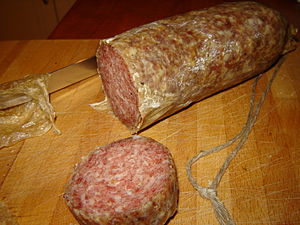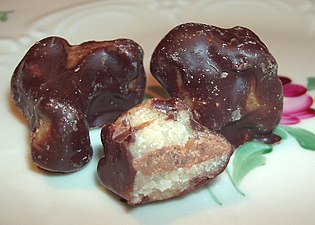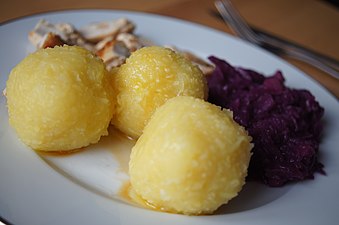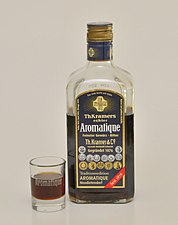to eat and drink in Thuringia offers more than the well-known Thuringian grilled sausages and Thuringian dumplings. The Thuringian cuisine is an overall rather hearty cuisine with an emphasis on meat and potatoes.

Rostbratwurst
Thuringian bratwurst is made from pork, or with veal or beef, which is seasoned with caraway seeds, garlic, pepper and salt and stuffed loosely into pork intestines or strings. The loose filling so that the sausage can puff itself when roasting.
Thuringian Rostbratwurst has been a protected geographical indication (PGI) since January 6, 2004; according to EU regulations, it is a medium-fine Rostbratwurst at least 15 cm long in a narrow natural casing, raw or boiled, with a spicy taste.
Raw grilled sausages ready to be grilled
Ready to eat with rolls and mustard
Rostbratwurst with sauerkraut and mashed potatoes
- 1 1. German Bratwurst Museum, Bratwurstweg 1, 99334 Amt Wachsenburg. Tel.: 49 3601 8571891. History, culture and art on the subject of bratwurst.Open: From April to October it is open Tuesday to Sunday and public holidays: 11 a.m. to 6 p.m.
Dumplings
Thuringian cuisine still knows many simple dishes from the times when the potato was the main food and was on the table with all meals. Around 1680, potato cultivation prevailed in the Thuringian region and soon afterwards potato dumplings replaced flour dumplings. First the potatoes were cooked in the farmers' kitchens. But word quickly got around, even among the gentlemen, that potato dumplings tasted better than the dumplings that were customary up until then, and so the triumph of Thuringian dumplings began and continues to this day.
The finished dumplings are waiting to be roasted
Rabbit, Thuringian dumplings and red cabbage
Quality seal of Thuringian dumpling
- Thuringian dumplings, Hat, also Knölla called, are made from raw, grated and boiled potatoes.
- When it comes to the Thuringian national dish, people have been arguing for ages about who they are real brings to the table. The recipes are very different from region to region, the admixtures range from flour to various spices.
- The Quality seal of Thuringian dumpling Has been awarded annually to Thuringian restaurateurs since 2013, who bring the dumplings fresh to the table according to traditional recipes. The award criteria can also be viewed by the guest. The owner of the seal, who stands for it with a declaration of honor, is responsible for compliance, there are no controls.
- According to legend, Ms. Holle should go to the mayor of Meiningen handed over the recipe for the really real Thuringian dumplings, with the words: Keep it and guard it, since then the dumplings have been made in Meiningen Hat called. The herding festival is also celebrated annually in honor of the potato dumpling.
- If dumplings are left over, they are cut into slices and sautéed in the pan. Often there is also the rest of the meat. There are many other ways to put the remaining dumplings on the table.
Baked dumpling slices with vegetables
Thuringian dumplings with Altenburg goat cheese
Filled dumplings with red and liver sausage
- Green dumplings In some areas, dumplings are called dumplings made only from raw potato paste.

- Dumplings are a variant of the potato dumpling. The rolled out dumpling dough with flour and egg is sprinkled with fried breadcrumbs and wrapped. Then the roll is cut to the size of a dumpling and the dumplings are then cooked in boiling water.
- 2 Thuringian Dumpling Museum, Hauptstrasse 3, 99439 Heichelheim. Tel.: 49 3643 4412245. With café, snack bar, factory outlet, children's dumpling world and ice cream museum.Open: Monday to Saturday 9 a.m. to 5 p.m., Sunday 11 a.m. to 5 p.m.
- 1 Grandma's dumpling kitchen - The focus of the restaurant in Schmoelln are dumplings in many variations, Thuringian dumplings, dumplings with different fillings, dumpling burgers, schnitzel wrapped in dumpling, etc.
roast meat
- Meat roast stands around Schmoelln and Altenburg in East Thuringia and in Thuringian woodland on the menu. It is a fist-sized piece of pork from shoulder or comb that is seasoned with salt, pepper, marjoram, marinated and ideally cooked in birch wood smoke on a roast stand. Bread, sauerkraut and mustard are often served with the meat roast.
- Schöpsbraten or lamb roast made from mutton
- Cabbage wrap are made from white or red cabbage leaves stuffed with pork
- Roulades are thin slices of meat, mostly from beef or veal, which are coated with mustard, stuffed, rolled up and braised. A filling with bacon, cucumber and onions is typical.
Meat roast
Beef roulade with red cabbage and bread and potato dumplings
Side dishes
- At the Red cabbage with apples or apple red cabbage, in addition to apples and spices, a little vinegar is added, which results in a sophisticated interplay of sweet and sour.
dishes
- A Thuringian Rostbrätel is a marinated slice of pork neck that is grilled. A marinade is made from beer with onions, garlic, mustard, caraway seeds, marjoram, salt and pepper and the roasted roast meats are put in cold for 12 to 48 hours. Bread or fried potatoes are served as side dishes.

Roasted roast meat in marinade

Rostbrätel with bread
Rostbrätel with mustard
- Seasoning meat is similar to ragout fin but with poultry or pork. The meat is cooked in broth and then cut into small pieces. A light sauce is made from the broth. Pieces of meat and sauce are gratinated with cheese and served with Worcestershire sauce, lemon and toast. The dish comes from the HO restaurants of the GDR and is usually served as a starter but also as a main course.
Seasoned meat is eaten with a spoon
- Schnippelsuppe is a hearty vegetable soup with potatoes, leek, carrots in meat broth, with soup meat or bacon and a dash of vinegar.
- Acid glue is a carnival dinner in Eichsfeld. It consists of leg, rib, paws, tail, snout of the pork, cooked with onions and vinegar, then a brown sauce is made from the brew with honey or breakfast cake (sauce gingerbread).
- In the 2 Zum Ziegenhainer restaurant in Jena stand frequently Goat dishes on the menu. From goat sausage to milk kid roast to milk kid liver.
- Milk soup with Pears and thieves are lumps of dough made from eggs, sugar, a pinch of salt and flour that are boiled in milk and thus made to stagnate. Finally, canned or fresh fruits are added to the milk soup with juice. In some regions, the milk is boiled with fried bacon before the dough and fruit are added. The name of the dough lumps varies from region to region.
miscellaneous
- Altenburger goat cheese is a soft cheese with 30 percent fat in the dry matter, which has been produced according to a traditional recipe in the Altenburger Land cheese dairy since 1897 Hartha and in the fine cheese dairy Zimmermann in Falcon Grove will be produced.
- Eichsfelder Feldgieker is a coarse-grained, cut-resistant raw sausage, similar to the Italian salami. It is made from lean pork and coarse bacon and seasoned with nitrite curing salt, pepper, honey and raspberry juice. After filling, the sausage ripens for several days and is then cold-smoked for a day. Often the edible sausage is then hung up for a few weeks to a year until the desired degree of hardness is reached. The Eichsfelder Feldkieker or Feldgieker has the status of PGI. - Protected geographical indication.
- The Eichsfeld calf bladder consists of pork that is filled into a bladder by the calf, which gives the sausage a spherical shape. After six months of ripening, the Eichsfeld calf bladder, produced without preservatives, can be kept for months. The Eichsfeld calf bladder is usually eaten on mixed bread with pickled cucumbers,
Altenburger goat cheese

Feldgieker, here as Eichsfelder Stracke
Eichsfeld calf bladder
- Mates A milk-soured white cabbage pickled in a special way is a traditional kitchen specialty from the Thuringian Rhön and around Kaltennordheim and Kaltensundheim. Chopped white cabbage is first cooked briefly and then, similar to sauerkraut, put in an earthenware barrel with brine for a few weeks together with dill to ferment.
Fish dishes
Trout
They are often floured as trout Miller or blue with boiled potatoes or smoked.
carp
They mostly will blue offered in vinegar stock with root vegetables and creamed horseradish.
The carp will be in Plothen pond area and in Schleizer Oberland specially prepared. The portioned and washed carp is cooked in a strongly seasoned root vegetable stock. The brew is processed into sauce with a stoving or sauce cake and refined with brown butter. The specialty is that Thuringian dumplings are served as an accompaniment to carp.
- in the 3 Gasthaus zum Plothenteich in Plotting there are Thuringian carp with dumplings from September to April.
Sweets
- In Thuringian bakeries you can get a variety of regionally different variants of the Sheet cake. In some villages there is still a communal oven in which cakes are baked for everyone. At parties, more than 10 types of sheet cakes are offered with coffee in the afternoon.
- Unstrutschlamm is a Mill houses Specialty made from marzipan and brittle, with a chocolate coating

Unstrutschlamm
- The Christmas cake, will Schittchen called
- Detscher used to be a feast for poor people. They are made from potatoes, eggs, flour, butter, and sugar. The 3-4 mm thick dough is baked golden yellow on both sides without fat and then coated with a butter-milk mixture and sprinkled with sugar. Traditionally, malt coffee is drunk with it. In Saalfeld the Detscher Festival is celebrated every year.
- 1 in the Berggold chocolate factory in Poessneck Pralines, jelly fruits, confectionery and seasonal products are offered
- 2 in the Viba nougat world in Schmalkalden offers an exhibition, hands-on courses, show and adventure confectionery, shopping shop, nougat bar counter and an Italian restaurant.
sweets
- The company Erich Wutzig from 07429 Sitzendorf is a family business in the 3rd generation of the popular Wusil peppermints here. They consist of sugar, peppermint oil, magnesium, gelatin, starch syrup and release agents and were already popular in the GDR.
beverages
Wine
The cross-border wine-growing region of Saale-Unstrut has a size of 765 hectares and a 1000-year tradition. The southern and southwestern parts of the wine-growing region are in Thuringia, the vast majority is expanding Saxony-Anhalt out. It extends from the Unstrut River Laucha up to the confluence with the Saale Naumburg and at the Saale from Jena to Burgwerben at Weissenfels. There are notable vineyards in Kaatschen, School gate and Bad Kosen. Outside the Saale-Unstrut area there are also vineyards in Bad Sulza on the river Ilm. The 60 km long Saale-Unstrut Wine Road runs through the area. Its northern location means that early-ripening varieties such as Müller-Thurgau, Pinot Blanc and Silvaner cultivated.
Outside Thuringia, vineyards are also used Time, on the sweet lake west of Hall, in Westerhausen north of the Harz Mountains, in Werder on the Havel counted as part of the Saale-Unstrut wine-growing region.

Saale-Unstrut Wine Route

Vineyard between Naumburg and Weißenfels
- in the 1 Thuringian winery Bad Sulza in Bad Sulza you can taste and buy wines.
beer
There are the big, well-known breweries like Köstritzer Schwarzbierbrauerei in Bad Köstritz, Oettinger Brewery in Gotha, or Braugold in Erfurt. But there are also the small, artisanal breweries.
- 2 Friedrichroda Brewery, Bachstrasse 14, 99894 Friedrichroda. Tel.: 49 3623 304259. Historic restaurant with guesthouse. The brewery is called the smallest brewery in West Thuringia, and Schackobräu Pils and Schackobräu Urbier are brewed. Brewery tours are offered.Open: Wednesday to Sunday 11 a.m. - 2 p.m., Monday to Sunday 6 p.m. - midnight.
- 3 Waldkasino - Erfurt brewery restaurant in Erfurt with its own brewhouse and various home-brewed beers.
- 4 Hotel & Braugasthof paper mill in Jena is a cozy brewery inn with a beer garden. Pils, Dunkels and Bock beer from one production
spirits
- Nordhäuser Doppelkorn is probably the most famous Thuringian spirit. Unlike other grain spirits that are distilled from wheat, the Nordhäuser is made from rye.
Liqueurs
A variety of herbs grow in the Thuringian Forest and so there is an old tradition for the production of herbal liqueurs.
- Aromatique is a bitter bitters from the Neudietendorfer spirits factory. At the beginning of the 19th century an epidemic broke out in Neudietendorf, a local pharmacist made an alcohol-containing remedy from natural substances and called this mixture tinctura aromatica composita. In 1828 medicine was further developed into the spirit Aromatique. Due to the immense demand, up to seven companies in Neudietendorf quickly produced aromatics. What is left to this day is today's:
- 3 Aromatique GmbH spirits factory, Am Hochheimer See 13, 99192 Nesse-Apfelstädt / OT Neudietendorf. Tel.: 49 36202 8840. Open: Factory sales Mon - Thu 7 a.m. - 3.30 p.m., Fri 7 a.m. - 11.30 a.m.
- 4 Liqueur factory Rudolf Trapp e. K, Froebelstrasse 1, 98744 Oberweißbach. Tel.: 49 36705 62314. The company was founded in 1919 by Rudolf Trapp and Hugo Kümmerling. Herbal and fruit juice liqueurs are made.Open: Factory sales Monday to Friday 8 a.m. - 12 p.m. and 1 p.m. - 5 p.m., Saturday 9.30 a.m. - 11.30 a.m.
- 5 Liqueur factory Arno Bechmann, Am Kesselrasen 2A, 98630 Römhild-Haina. Tel.: 49 36948 21297. The liqueur factory was founded in 1946. In the 1960s, 35 different spirits were produced, under the dictates of the GDR management there were only 5 types. Today the liqueur factory is run in the 3rd generation.Open: Factory sales Monday to Friday 7:00 a.m. to 6:00 p.m., Saturday and Sunday by appointment.
- 6 Grandma Friedels, Helmsgrün 77, 07356 Bad Lobenstein. Tel.: 49 36651 37782. Eggnog, chocolate liqueur, different flavors and mixtures.
Aromatique
Rhöntropfen
- Herbal liqueur from Rhöntropfen Meiningen
ingredients
mustard
- 7 BORN Mustard Shop & Museum out Erfurt is the mustard that is traditionally served with bratwurst in Thuringia. In 1820 the brothers Wilhelm and Louis Born founded a mustard mill. There is now a large number of different mustards, which everyone has to find out for themselves which goes best with the bratwurst.
- 8 Jena mustard factory and the small mustard museum in Jena. Mostly handcrafted mustard without chemical additives. Also mustard noodles, mustard chocolate and mustard schnapps.
- 3 Art and mustard mill Kleinhettstedt, Kleinhettstedt 44, 99326 Ilmtal, Germany. Tel.: 49 3629 3596. The mustard mill was first mentioned in the 16th century. You can find out about mustard production, buy mustard and stop for a mustard dish at the mill landlord opposite.Open: Open from April to November, Tuesday to Saturday from 10 a.m. to 6 p.m., Sunday from 10 a.m. to 5 p.m. and from December to March Tuesday to Sunday from 10 a.m. to 4.30 p.m., closed on Mondays.
asparagus
The asparagus acreage in Thuringia has increased tenfold over the past 20 years. The main growing areas are around Kutzleben, Autumn life, Greed City, Kindelbrück, Weissensee or in East Thuringia Gimmel. Asparagus has been grown in the Thuringian Basin for 200 years.
If possible, you should buy asparagus fresh from the producer, long transport does not improve it. If the cut ends aren't dried out and the asparagus spears squeak when you rub them together, then it's fresh. With some asparagus farmers you can have the stalks peeled right away.
The white pale asparagus only grew underground and saw no sunlight. The green asparagus was harvested above the ground.
The Asparagus season depending on the soil temperature, goes from mid-April to St. John's Day on June 24th, after which the asparagus is allowed to grow in order to gather strength for the next year's harvest. Today, asparagus fields are covered with black plastic sheeting to accelerate the heating of the soil in spring so that the first stalks can be pricked earlier.
Culinary calendar
January
February
March
April
- Asparagus season
- In Erfurt the opening of the barbecue season is celebrated on one weekend on Domplatz, with around 20 variations of the Thuringian Rostbratwurst
May
- Asparagus season
June
- The Asparagus season ends on Midsummer Day, June 24th,
- The Jena Wine Festival
July
- The first weekend will be in Meiningen the Herding festival celebrated. Around 30,000 visitors come to Thuringian dumplings, the so-called Hat to eat.
August
- In August / September is Mushroom season, Boletus and other wild mushrooms enrich the menu.
- On a Saturday in mid-August, in Saalfeld the Detscherfest celebrated. The sweet potato pastries are baked on numerous ovens.
- On the third weekend in Bad Sulza and the wine festival celebrated in Erfurt, with wines from the Saale-Unstrut region
- A wine festival will be celebrated in Naumburg on the fourth weekend
- From the Friday of the last week of August to the Sunday of the following week, in Mulhouse Fair is celebrated with Mühlhäuser plum cake and pork knuckles.
September
- In August / September is Mushroom season, Boletus and other wild mushrooms enrich the menu.
- Federweisser festivals in various wineries
- On the second Saturday in Heichelheim near Weimar that will Heichelheim Potato Festival celebrated.
- On the third weekend, the autumn wine festival is celebrated in the state winery "Kloster Pforta", Bad Kösen.
October
- Federweisser festivals in various wineries
.JPG/250px-Weimar-Zwiebelmarkt_(3).JPG)
- On October 3rd, the Thuringian Rostbratwurst will take place in Holzhausen near Arnstadt Bratwurstiade instead, with fun competitions that are all about the sausage.
- The Weimar onion market (Zippelmarkt) takes place on the second weekend in October and attracts up to 350,000 visitors. For over 300 years (1653), the onion festival has been held in the Goethe and Schiller cities. A good five hundred market stalls in the old town provide visitors with Weimar onion tarts and other onion-related delicacies and many other dishes.
November
December
- On the Christmas markets culinary discoveries can also be made in the region.
literature
Recipes
If you feel like enjoying Thuringian cuisine at home, you will find the appropriate recipes in Koch Wiki under Category: Thuringian cuisine. Have fun cooking at home.




















Blase.JPG/340px-Eichsfelder_(Kälber-)Blase.JPG)





